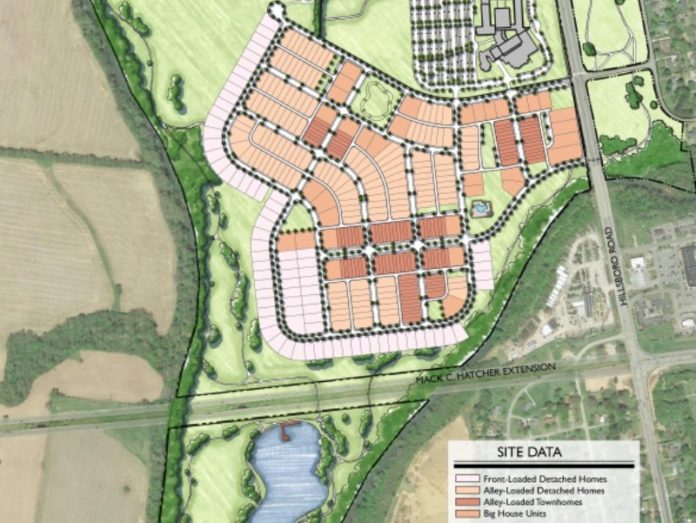After two years of locked horns over the Brownland Farm development proposal, at the September 14 meeting of the Board of Mayor and Alderman (BOMA) nerves were frazzled and patience was running thin as updated data on the flood plains arose in the eleventh hour. This new information in regard to the effect of climate change on FEMA’s assessments of 100- and 500-year flood plains brought forth significant comments from the city staff, the developer, and interested parties both for and against going forward with the building of a 471-residential unit development that would encompass the Brownland Farm property and part of the land around Christ Community Church.
The crux of the new argument against going forward with the development is based on a reassessment of information from FEMA on how 100- and 500-year flooding would affect access to the development during a flood. As part of the creation of the site, the current floodplain, which extends over three large sections of the area, will have to be manipulated. This manipulation will create more area to build much-needed single-family homes, townhomes, multiplexes and multifamily buildings.
All estimates on how the land would be affected by flooding was, according to City Administrator Eric Stuckey, inaccurate and new recently obtained input showed that the flood plain would be considerably higher than previously estimated, making the new development inaccessible by first responder vehicles should there be an emergency after a very heavy rain.
Planning Supervisor Amy Diaz-Barriga noted that Envison Franklin, a document that articulates the vision for future development of the city, addresses the floodplain issue, stating that nothing should be built on the floodplains that are currently being addressed. If the development was being proposed on another piece of land, she said it would readily be approved.
One of the speakers against the development was Dorie Boize, President and Chief Executive Officer of the Harpeth Conservancy. She brought up three points that were reiterated by most of those opposing the development:
- City stormwater and floodplain management requires that there must be an emergency bypass for 100-year flooding and that existing and critical service roads may not have more than three inches of water over more than half of the road. With the new flood estimates that came to light, current plans by the development for water management would not meet these requirements. Flooding on these roads could be as much as two feet.2. The floodplain alteration proposal by the developer affects 80% of the site, but it does not improve the floodplain, it simply alters it for maximization of land usage. It does not reduce flood risk for older developments in the area.
3. Climate change has brought about an 18% increase in top rainiest days over the last 30 years, and floodplains have changed. Homes in some areas that were not in the floodplain at all when built, now fall within it.
Greg Gamble, owner of Gamble Design Collaborative, who is acting as the planner for the project, explained that the development will have detention areas providing additional capacity for storm water during a flood.
“We need the additional 28 million gallons of storage that Brownland is proposing within the neighborhood in this community,” said Gamble, who lives in the area.
Both the developer, Kevin Estes of Land Solutions, and Robin and Michelle Anderton, owners of Brownland Farms, gave impassioned statements about the frustration they are feeling. Estes was upset that he had just heard of the new flooding concerns a few hours before the meeting. The Andertons were not only upset over the time it has taken to move things forward, but also the ugliness they have been receiving about the plans for their farm on social media.
“We care about the community,” said Michelle Anderton,” and feel this development is good for the community.”
Even Alderman Beverly Berger voiced some annoyance at the project taking so long to come to completion. Franklin is in need of additional housing with all of the new growth.
While city staff and Franklin Municipal Planning Commission both disapproved the proposal, the BOMA initially voted to approve the rezoning necessary for the project to go forward, but the approval of the development plan was deferred until the October 12 meeting at Estes’ suggestion so that he and the city staff can sit down and find a way to solve the problem created by the new flood information.
Please join our FREE Newsletter




















In March of this year when the Harpeth River flooded, it flowed 5,420 cubic feet per second. That’s over 2.4 million gallons per minute. So, the 28 million gallon additional retention capacity that the developer likes to crow about would be filled in a scant 12 minutes, as there are 7.48 gallons in a cubic foot of water. Of course the flood went on for days. Building in flood plains is a very bad idea.